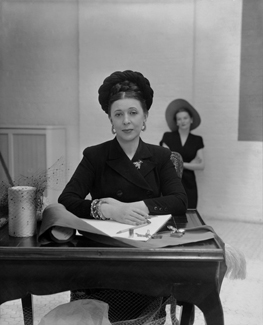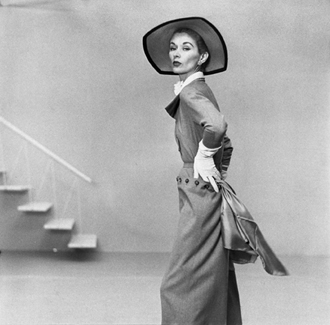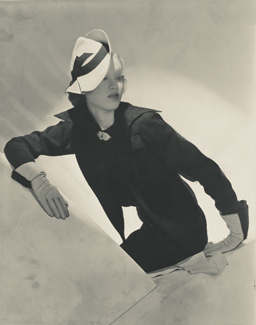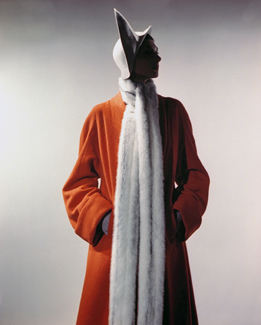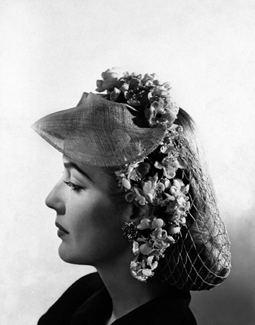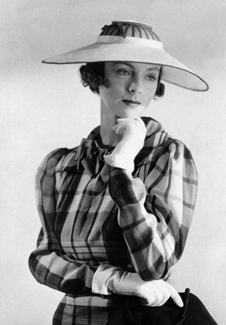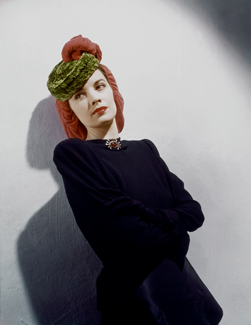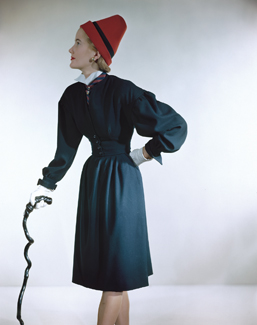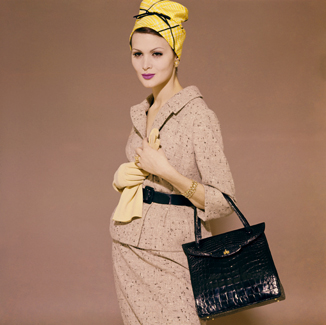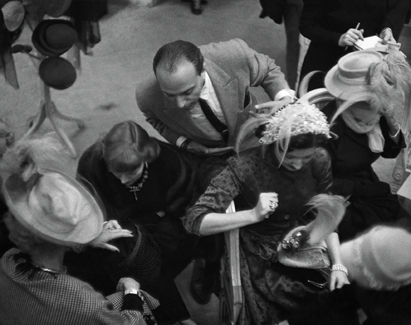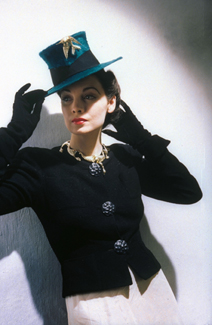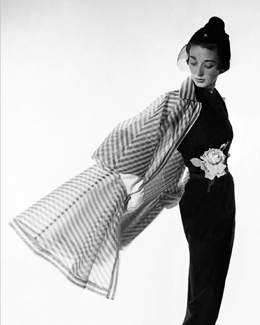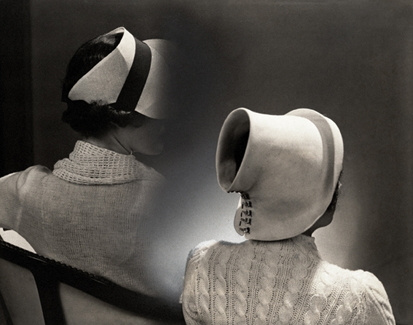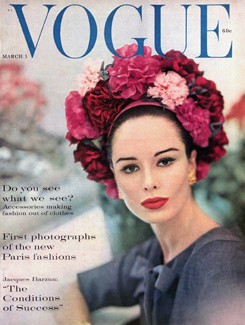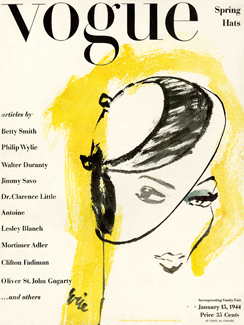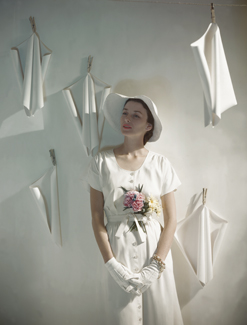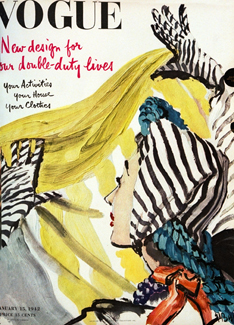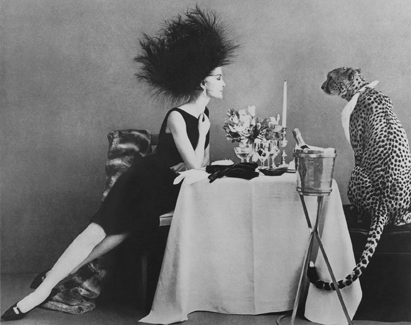The American Millinery Triumvirate
“For the first time in memory an Autumn mode is born without the direct inspiration of Paris . . . American talent has risen to the occasion,” proclaimed the September 1, 1940 issue of Vogue. The events of World War II helped develop three stars in American millinery. Lilly Daché, Sally Victor, and Mr. John were already established milliners during the 1930s, but the pressures of the war and loss of the guidance of Paris fashion helped to propel their careers into the spotlight and make them household names.
A Vogue favorite, Lilly Daché was born in France and trained in Paris under Caroline Reboux.
Daché came to the United States during the 1920s and worked in the millinery department at Macy’s, then in a small millinery shop. After women kept buying the hats she made for herself right off of her head, she decided to buy the shop she was working in and start her own business. By 1937, her business occupied an entire building at Park Avenue and 56th Street, where 150 workers helped turn out her creations.
Daché crafted the famous slouch hat for Greta Garbo and also counted movie stars Loretta Young, Joan Crawford, Marlene Dietrich, and Rosalind Russell among her clients. Turbans, doll hats, and tricks with netting were some Daché trademarks. Her business closed in 1968.
Sally Victor (née Josephs) also worked in the Macy’s millinery department. In 1934, she married Sergiu Victor, a millinery manufacturer, who helped her set up her own shop and later joined her in her business. By1959, Sally Victor was the largest millinery company in America.
Victor was known for her use of color and for deliberately seeking inspiration from history and architecture (she once created the Guggenheim Museum as a straw hat.) She was also famous for cribbing ideas from other cultures.
She haunted museums to get ideas, and in 1941, the Brooklyn Museum, one of her favorite resources, mounted an exhibition called “Hats Unlimited“ centered on her work and how she used the museum for her ideas. (this is on view at the brooklyn museum website- is it possible to post the link?
Victor hatted several First Ladies, including Elizabeth Truman, Mamie Eisenhower, and Eleanor Roosevelt, as well as Queen Elizabeth II and model and socialite Babe Paley. Victor retired in 1968.
Born John Harberger in 1902, Mr. John apprenticed with his mother, who was a milliner, and started his own business in 1928 as the John behind the John-Frederics hat label, with partner Frederic Hirst.
Known for his mad personality and mad hats to match, Mr. John‘s creativity came through mainly in the shapes of his hats, rather than through the use of flowers and frippery. A bubble, a stingray, a coal scuttle; however unusual the shape, he made it to flatter the wearer. Mr. John hats could be as simple as a beret, or as wild as his banana hat that unpeeled with a zipper.
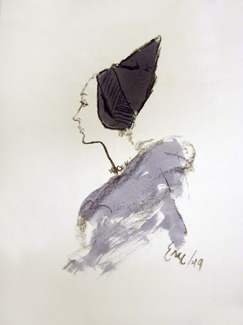
Eric illustration of a model wearing a very tall cone shaped hat with side flaps that cover the ears by John Frederics.
John was a true showman and sometimes played up his resemblance to Napoleon in the way he dressed. In 1948, the same year he officially changed his name to John P. John, he opened his own hat salon on East 57th Street in New York. His showroom reflected his madcap style: elaborate red and gold rococo décor, with fitting rooms resembling giant birdcages and a live parrot that was left uncaged and had free reign of the shop. Mr. John closed his business in 1970.
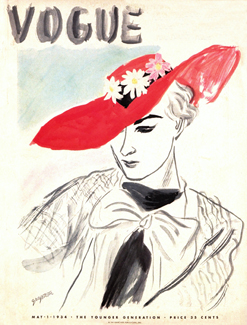
May 1934 Vogue cover illustration of woman wearing big red straw hat trimmed with pink and white daisies by Lilly Daché.

July 1957 Vogue cover featuring a model wearing a wide brimmed hat with butterflies on the crown by Sally Victor.
The work of all three of these milliners was routinely featured on Vogue covers, all three won many prestigious fashion awards, and each toiled for the war effort during World War II. All made hats for films (most of them uncredited, or with their work attributed to movie costumers), and in doing so, helped to set the recognizable look of different American screen icons. It is hard to imagine the face without the hat when one thinks of Marlene Dietrich in Shanghai Express or Vivien Leigh in Gone with the Wind (both in Mr. John hats), and equally hard to picture Carmen Miranda without her magnificent Lilly Daché turbans.
Despite the vicissitudes of the millinery industry in general, the businesses started by Lilly Daché, Sally Victor, and Mr. John remained strong for more than 50 years due to their uncommon ability to see times changing and adapt. After World War II and through the 1960s, the members of this millinery triumvirate were vigilant in their efforts to continue making headwear that women wanted. For the burgeoning teen population, they created hats with youthful styling that were sold at lower price points. Daché started the Dachettes line, Mr. John had Mr. John Jr., and Sally Victor had the Sally V line. To stay in touch with the desires of young people, Lilly Daché hired Roy Halston, then in his 20s, to work as her apprentice.
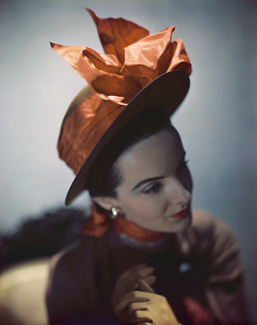
Model wearing Lilly Daché's toast-colored sailor style hat with tangerine bow, pushed back on her forehead.

September 15, 1963 Vogue cover with a model wearing a white satin Mr. John domed helmet hat with a chin strap.
In the early 1960s, when elaborately styled hair began to usurp the role of hats, all three milliners made extra efforts to coordinate their hat styles with hairstyles and expand their businesses from hatwear to the more general headwear. Mr. John began to sell wigs and hair pieces alongside his hats, and Sally Victor sold hair accessories. The three experimented starting from the earliest signs of the wane in hats popularity, making large hats that went over delicately and protected more ornate hairstyles; small hats which could sit atop a high coiffure; and scarves, hoods, and hair accessories to enhance hairdos. They even made hats that mimicked the look of hair. Lilly Daché hired the famed hairdresser Kenneth to work out of her hat salon so she could span the hat/hair market more easily.
These three stars were survivors who maintained their businesses well into a time when hats were considered “finished“ in fashion, by adapting and innovating. Although they were competitors, Daché, Victor, and John worked together for the cause of millinery, and this effort was beautifully supported in the pages of Vogue.
